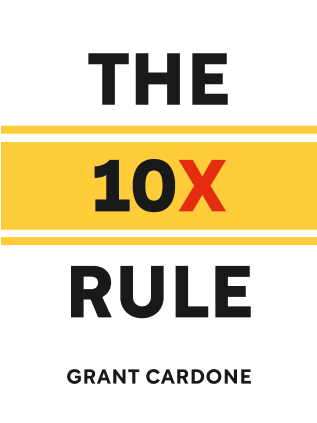

This article is an excerpt from the Shortform book guide to "The 10X Rule" by Grant Cardone. Shortform has the world's best summaries and analyses of books you should be reading.
Like this article? Sign up for a free trial here .
What is the 10X planner? How does this strategy help you apply the lessons of the The 10X Rule?
The 10X planner is a strategy for implementing the 10X rule for your goals. There are 4 lessons you need to incorporate for an effective 10X planner.
Read more about using the 10x planner.
Using the 10X Planner
Cardone learned four lessons about operating by the 10X Rule when he started his first business age 29. In preparing for the 10X system, use these lessons in the 10X planner.
Lesson #1: Beware of Underestimating
Underestimating what it will take to achieve your goal has a debilitating effect. When you miscalculate, you become discouraged, you rationalize and attribute your problems to the wrong factors, you assume your goal is unreachable and you give up.
Whether you’re starting a business, building a house, raising money, or searching for a new job, it will always take more effort than you initially expect. No matter how great your new product or service is, there will be something you didn’t expect or properly plan for—for example, economic changes, legal issues, competition, or people problems.
Extreme effort is the only thing that will overcome these obstacles; throwing money at them won’t do it. To use a battle metaphor, you can’t just take a territory—it takes persistence and sustained effort to keep it.
When you accurately estimate what it will take, you’ll approach the job with the right mindset—a determination to go all out—and the market (your customers and competitors) will respond to your forcefulness.
Lesson #2: Don’t Scale Back Your Goal
When things don’t go as planned, people’s response is often to scale back the goal rather than increase their efforts.
Many sales managers do this with sales teams. They set a quota for the quarter, but when sales come up short at the halfway point, they reduce the goal in an effort to keep people motivated by giving them a better chance of hitting a target.
This is a major mistake because it has the opposite effect. It sends the message that targets are changeable and the way to win is to move the goalposts. Ultimately, this weakens morale and expectations of excellence, and it encourages excuses. The best managers push people to do more and risk failure, rather than reducing goals. Never lower a goal—instead, increase your effort. In the 10X planner, you would incorporate this technique.
When you start scaling back your goals, you’re giving up on your dreams and yourself. The urge to adjust the target is a sign you’re getting off track. It should prompt you to correct your estimate of what it will take and ratchet up your efforts.
Under the 10X Rule, the goal is never the problem. Any goal is reachable when you persist with the right actions in the right amounts.
Lesson #3: Take Extreme Action
Assume every task or project will take more time, resources, and effort than you expect. Multiply each of your expectations by 10 and you’ll probably be up to the task. If it takes less time or effort, no problem—it’s better to be pleasantly surprised than unpleasantly surprised.
When you’ve marshaled 10 times the resources you’ll potentially need, you’ll be positioned to deal with unplanned problems, such as economic downturns, competition, or market resistance.
If you’re introducing a new product, do 10 times more than you would to promote an established product.
Whatever your project is, tackle it with the 10X Rule, as though your life depends on it. Build this effort into your preparation in the 10X planner.
Lesson #4: Follow Through
When you’ve taken the plunge to pursue a goal, make sure you follow through completely.
Adopt the mindset that you’re “in it to win it, no matter what it takes,” as if you’re an athlete with one last chance to make the record books.
Luck may play a role, but even luck is proportional to effort. The more you do, the more likely you are to get lucky.
Applying The Lessons in the 10X Planner
Here’s how Cardone used these lessons to rejuvenate his first business when it floundered:
Because most businesses lose money at first, Cardone expected financial losses and thought he was prepared for them. He estimated it would take three months to build his business to the point of producing the same income he received from his previous job. However, it took 12 times that amount of time (three years).
He nearly quit after three months because of the obstacles he ran into and disappointment. He had many rationales for why things weren’t working out. He made a long list so he could justify quitting. Reasons included: his timing was bad, he was too young, his clients didn’t have enough money, his clients didn’t get it, people weren’t willing to change, the economy was terrible, he was terrible, and others were terrible.
However, he finally realized his business was struggling because he had underestimated what it would take to get a new product to the market and attract enough attention that people would buy it.
He had little money, so he couldn’t hire people and advertise the product. His only way of letting people know about it was by cold calling potential customers. The only resource he had the ability to increase was his effort. He would need to make many more cold calls.
As soon as he ratcheted up his efforts by a factor of 10, things began to improve. Instead of making a handful of sales calls a day, he made 20 or 30. It was difficult and he still experienced disappointments, but by making 10 times his original effort, he quadrupled his results.

———End of Preview———
Like what you just read? Read the rest of the world's best book summary and analysis of Grant Cardone's "The 10X Rule" at Shortform .
Here's what you'll find in our full The 10X Rule summary :
- How to set goals that are 10 times bigger than average
- How to use extraordinary thinking to achieve extraordinary results
- The 3 myths that will sabotage your chances of success if you let them






